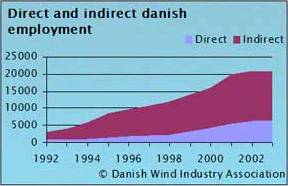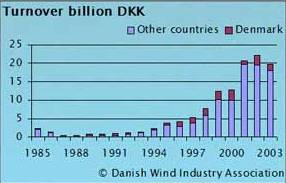|
Comparisons with Onshore Wind Power Industry in Denmark
What comparisons can be drawn from the development of the Danish on-shore wind industry from the 1970’s?
- UK & Scotland is in a similar situation to Denmark in the 1970’s
- Scotland is ideally placed to mimic the Dane’s success story
- Many of the World’s leading academics and experts in wave and tidal energy are in resident in the UK
- Aside from the energy issue there is a considerable potential to export technology worldwide and become a World leader in MCT’s
- Benefits to export economy and skilled jobs market
In depth Analysis
Evolution of Danish Wind Power Industry
Workforce in 1981 was only a few hundred
- Now total employment has expanded to 20,000

Note
Calculation methods in WindPowerNote No. 2, November 1995.
Employment figures are mid-year figures.
Source: http://www.windpower.org/en/stats/totalemployment.htm
Industry now has turnover of DKK 20 billion (1.5 million Euros)

Source: http://www.windpower.org/en/stats/turnover.htm
- Export of technology
- Around 50% of installed wind capacity is Danish in origin
- 4 major turbine manufacturers:
- Vestas
- NEG Micon
- Bonus
- Nordex (no longer manufacture turbines)
- Numerous smaller component manufacturers
Why the success story?
- By accident?
- As a result of concerted effort by Danish government to promote the industry?
Danish Government Commitments
- Refusal to adopt nuclear power
- Halt to proposed new coal fired plants
- Grants for R&D
- Tariffs & incentives
- Offshore plans
- Higher wind velocities leading to greater energy yields (cubic relationship)
- Potential to produce 50% of Denmark’s electrical demand (1/4 of total energy demand)
- Grid priority to renewable-generated electricity
- Historical Commitment to expanding Wind Power Industry by Policy and continual and consistent adoption by successive governments
- 1970’s
- Mandatory purchase of electricity from private wind companies at 85% retail price
- 1979-1989
- Capital Grants programme
- “10% from wind” target set in mid 80’s
- Target met and exceeded by 2000
- 1996
- Energy 21, target of 45% from wind by 2030
- Will entail additional 5,500 MW installed capacity
- Likely to be met by offshore developments
- 2003
- Improvement of subsidies and inclusion of earlier projects in new subsidy schemes to safeguard investments
Lessons from Danish Experience
- Government must provide incentive to investors by:
- removing uncertainty and unnecessary risk
- Pledging long term tariffs and grants
- Increase value of capital grants for marine renewables projects
- Manage the £50 million “R&D to pre-commercial” fund diligently
- Promoting Connection of renewables to grid
- Resolving electricity market trading barriers
- Be technology/ source specific with ROC/ROS
- Otherwise utility companies will opt for cheapest form of renewable generation (e.g biomass, on-shore wind, hydro etc.)
Implementing Danish Lessons into a UK context
- Look at progression of UK on-shore wind industry
- Will marine renewables take a similar path?
- OR will it be more closely aligned with offshore wind or indeed offshore industry in general?
- What are the similarities and differences?
- Safety issues
- Installation costs- moorings, seabed assessment etc.
- Planning permission
- Grid connection
- More costly by a factor of 1 magnitude compared with on-shore wind
- Leading to increased capital costs from outset
- Different funding strategy required
- Economies of scale
- Larger scale farms will lead to reduced costs
- Even if government fails to attract backing from a moral “carbon-reducing” perspective, one cannot ignore the huge potential for economic growth existing in marine renewables
- Government has 2 options:
- “import” clean energy technologies
- Effectively allowing other countries to invest and carry out the work
- Or develop World’s leading marine renewables industry in the UK
- The later option would:
- Enable UK to reap the combined benefits of economic growth and diversity
- In addition to meeting the environmental and carbon sequestration challenge, so clearly sighted by the government as a target for 2020 and beyond
|
|

